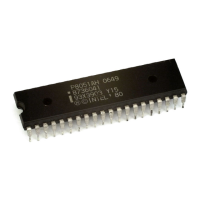i~o
MCS@-51 ARCHITECTURAL OVERVIEW
but the stack itself is accessed by indirect addressing
using the SP register. This means the stack can go into
the Upper 128, if they are implemented, but not into
SFR space.
In devices that do not implement the Upper 128,if the
SP points to the Upper 128,PUSHed bytes are lost, and
POPped bytes are indeterminate.
The Data Transfer instructions include a id-bit MOV
that can be used to initialise the Data Pointer (DPTR)
for look-up tables in Program Memory, or for Id-bit
external Data Memory accesw.
The XCH A, <byte> instruction causes the Amu-
lator snd addressed byte to exchsnge data. The
XCHD
A,@Ri instruction is similar, but only the low nibbles
are involved in the exchange.
To see how XCH and XCHD can be used to fatitate
data manipulations, consider first the problem of shit%-
ing an 8digit BCD number two digits to the right. Fig-
ure 11 shows how this can be done using direct MOVS,
and for comparison how it can be done using XCH
instructions. To aid in understanding how the code
works, the contents of the registers that are holding the
BCD number and the content of the Accumulator are
shown alongside each instruction to indicate their
status after the instruction has been executed.
n3JMm
MOV A,2EH
MOV 2EH2DH % ;; : % ~
MOV 2CH:2BH 00 12
(a) Using direct MOVS 14 bytes, 9 ps
~
gm
(b) Using XCHS 9 bytes, 5 ps
. .
Figure 11. Shifting a BCD Number
Two Dlgite to the Right
Atler the routine has been executed, the Accumulator
contains the two digits that were shitled out on the
right. Doing the routine with direct MOVSuses 14code
bytes and 9 ps of execution time (assuming a 12 MHs
clock). The same operation with XCHS uses less code
and executes almost twice as fast.
To right-shift by an odd number of digits, a one-digit
shift must be executed. Figure 12 shows a sample of
code that will right-shii a BCD number one digi~ us-
ing the XCHD instruction. Again, the contents of the
registers holding the number and of the Accumulator
areshownalongsideeachinstruction.
MOV Rl, #2EH
MOV RO,#2DH
m
loop for R1 = 2EH
.00P MOV A,@Rl 00 12 34 56 78 76
XCHD A,@RO
00 12 34 56 78 76
SWAP A
00 12 34 58 78 67
MOV @Rl,A
00 12 34 58 67 67
DEC RI
00 12 34 58 67 67
DEC RO
00 12 34 56 67 67
CJNE Rl,#2AH,LOOP
Imp for RI = 2DH
00 12 36 45 67 45
loop for R1 = 2CH:
00 18 23 45 67 23
ioop for RI = 2BH:
0s
01 22 45 67 01
CLR A
06
01 23 45 67 00
XCH A,2AH
00 01 23 45 67 06
Figure 12. Shifting a SCD Number
One Digit to the Right
First, pointers RI and ROare setup to point to the two
bytea containing the last four BCD digits. Then a loop
is executed which leaves the last byte, location 2EIL
holding the last two digits of the shifted number. The
pointers are decrernented, and the loop is repeated for
location 2DH. The CJNE instruction (Compare and
Jump if Not Equal) is a loop control that will be de-
scribed later.
The loop is executed from LOOP to CJNE for R1 =
2EH, 2DH, 2CH and 2BH. At that point the digit that
was originally shii out on the right has propagated
to location 2AH. Siice that location should be left with
0s, the lost digit is moved to the Accumulator.
1-13

